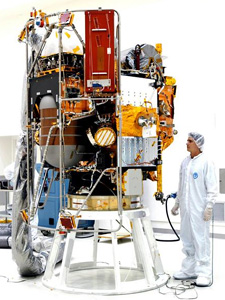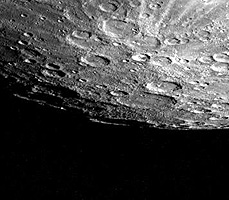Geotimes

Untitled Document

Web Extra
Wednesday, August 4, 2004
Slow boat to a small planet
 For the
first time in more than three decades, scientists are going to get a close-up
view of Mercury, Earth's smallest neighbor and the rocky planet closest to the
sun. The mission MESSENGER (for "Mercury Surface, Space Environment, Geochemistry,
and Ranging") launched successfully from Cape Canaveral in Florida yesterday.
For the
first time in more than three decades, scientists are going to get a close-up
view of Mercury, Earth's smallest neighbor and the rocky planet closest to the
sun. The mission MESSENGER (for "Mercury Surface, Space Environment, Geochemistry,
and Ranging") launched successfully from Cape Canaveral in Florida yesterday.
Before MESSENGER was launched yesterday from the Kennedy Space Center, a worker
inspected it during its final tests and assembly at Astrotech Space Operations
in Titusville, Fla. Image courtesy of NASA.
Set to first reach Mercury in 2008, the tiny spacecraft will shoot past Earth
in 2005, round Venus twice and then take a slingshot path back toward its goal.
The extra loops are to help slow down the speeding craft, so it can coast into
an orbit around the planet. NASA plans for three flybys of Mercury in three
years; MESSENGER is scheduled to settle into orbit by March 2011.
The last images sent to Earth from Mercury were from Mariner 10, from 1974
to 1975. Scientists are still piecing together that data, which captured only
half the planet. "We know almost nothing about Mercury's composition,"
says Sean Solomon of the Carnegie Institution of Washington and the principal
investigator on the project. "Mariner 10 did not do any remote geochemical
sensing," and MESSENGER will see that unknown side of the planet for the
first time in its first two passes.
 The
project, one of over half a dozen small exploratory missions that NASA initiated
in the 1990s, cost around $427 million. Equipped with a multitude of instruments,
most of which were produced at the Applied Physics Laboratory of Johns Hopkins
University, MESSENGER's mission is to answer key science questions regarding
Mercury's density, geologic history and core composition. Most mysterious is
why the planet has a magnetic field like Earth's, even though Earth's other
sister planets, Venus and Mars, do not. Researchers would also like to know
if Mercury experienced volcanism.
The
project, one of over half a dozen small exploratory missions that NASA initiated
in the 1990s, cost around $427 million. Equipped with a multitude of instruments,
most of which were produced at the Applied Physics Laboratory of Johns Hopkins
University, MESSENGER's mission is to answer key science questions regarding
Mercury's density, geologic history and core composition. Most mysterious is
why the planet has a magnetic field like Earth's, even though Earth's other
sister planets, Venus and Mars, do not. Researchers would also like to know
if Mercury experienced volcanism.
Mercury's south pole as viewed by Mariner 10 on a flyby in the 1970s. Some Earth-based
observations indicate there may be water ice or other captured volatiles in
the cold dark corners of some impact craters at Mercury's poles. Image courtesy
of NASA.
Among the instruments onboard are gamma and X-ray spectrometers to track the
abundance of elements in Mercury's crust and a laser altimeter for detailed
surface mapping. Two instruments — a magnetometer and particle spectrometer
— will further document the planet's magnetic field and magnetosphere.
Another instrument that measures how MESSENGER's velocity changes in orbit will
give data for crustal thickness and mass distribution.
After its instruments peer at the magnetic field, atmosphere, surface and innards
of the planet, MESSENGER will end up crashing on Mercury, from its orbiting
perch 200 to 15,000 kilometers above the surface.
Naomi Lubick
(Updated on Thursday, Aug. 5, 2004)
Links:
NASA's
MESSENGER Web site
The
Johns Hopkins University Applied Physics Laboratory MESSENGER Web site
Back to top
Untitled Document

 For the
first time in more than three decades, scientists are going to get a close-up
view of Mercury, Earth's smallest neighbor and the rocky planet closest to the
sun. The mission MESSENGER (for "Mercury Surface, Space Environment, Geochemistry,
and Ranging") launched successfully from Cape Canaveral in Florida yesterday.
For the
first time in more than three decades, scientists are going to get a close-up
view of Mercury, Earth's smallest neighbor and the rocky planet closest to the
sun. The mission MESSENGER (for "Mercury Surface, Space Environment, Geochemistry,
and Ranging") launched successfully from Cape Canaveral in Florida yesterday.
 The
project, one of over half a dozen small exploratory missions that NASA initiated
in the 1990s, cost around $427 million. Equipped with a multitude of instruments,
most of which were produced at the Applied Physics Laboratory of Johns Hopkins
University, MESSENGER's mission is to answer key science questions regarding
Mercury's density, geologic history and core composition. Most mysterious is
why the planet has a magnetic field like Earth's, even though Earth's other
sister planets, Venus and Mars, do not. Researchers would also like to know
if Mercury experienced volcanism.
The
project, one of over half a dozen small exploratory missions that NASA initiated
in the 1990s, cost around $427 million. Equipped with a multitude of instruments,
most of which were produced at the Applied Physics Laboratory of Johns Hopkins
University, MESSENGER's mission is to answer key science questions regarding
Mercury's density, geologic history and core composition. Most mysterious is
why the planet has a magnetic field like Earth's, even though Earth's other
sister planets, Venus and Mars, do not. Researchers would also like to know
if Mercury experienced volcanism. 